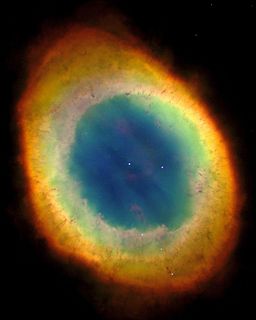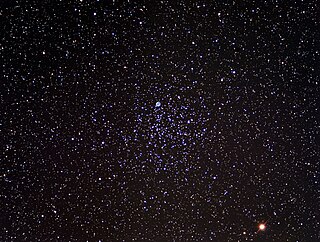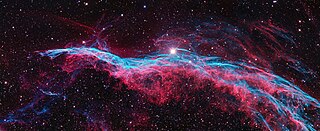
Sagittarius is one of the constellations of the zodiac. It is one of the 48 constellations listed by the 2nd-century astronomer Ptolemy and remains one of the 88 modern constellations. Its name is Latin for the archer, and its symbol is , a stylized arrow. Sagittarius is commonly represented as a centaur pulling back a bow. It lies between Scorpius and Ophiuchus to the west and Capricornus and Microscopium to the east.

A tobacco pipe, often called simply a pipe, is a device specifically made to smoke tobacco. It comprises a chamber for the tobacco from which a thin hollow stem (shank) emerges, ending in a mouthpiece. Pipes can range from very simple machine-made briar models to highly prized hand-made artisanal implements made by renowned pipemakers, which are often very expensive collector's items. Pipe smoking is the oldest known traditional form of tobacco smoking.

Brunswick County is the southernmost county in the U.S. state of North Carolina. As of the 2010 census, the population was 107,431. As its population was only 73,143 in 2000, that makes it one of the fastest growing counties in the state, at a nominal growth rate of about 47% in ten years, with much of the growth centered in the eastern section of the county, the suburbs of Wilmington such as Leland, Belville and Southport. The county seat is Bolivia, which at a population of around 150 people is among the least populous county seats in the state.

Carolina Shores is a town in Brunswick County, North Carolina, United States. The population was 3,048 at the 2010 census, up from 1,482 at the 2000 census. It is part of the Myrtle Beach metropolitan area.

An emission nebula is a nebula formed of ionized gases that emit light of various wavelengths. The most common source of ionization is high-energy photons emitted from a nearby hot star. Among the several different types of emission nebulae are H II regions, in which star formation is taking place and young, massive stars are the source of the ionizing photons; and planetary nebulae, in which a dying star has thrown off its outer layers, with the exposed hot core then ionizing them.

The Orion Nebula is a diffuse nebula situated in the Milky Way, being south of Orion's Belt in the constellation of Orion. It is one of the brightest nebulae, and is visible to the naked eye in the night sky. M42 is located at a distance of 1,344 ± 20 light years and is the closest region of massive star formation to Earth. The M42 nebula is estimated to be 24 light years across. It has a mass of about 2,000 times that of the Sun. Older texts frequently refer to the Orion Nebula as the Great Nebula in Orion or the Great Orion Nebula.

Draco is a constellation in the far northern sky. Its name is Latin for dragon. It was one of the 48 constellations listed by the 2nd century astronomer Ptolemy, and remains one of the 88 modern constellations today. The north pole of the ecliptic is in Draco. Draco is circumpolar, and can be seen all year from northern latitudes.

The Eagle Nebula is a young open cluster of stars in the constellation Serpens, discovered by Jean-Philippe de Chéseaux in 1745–46. Both the "Eagle" and the "Star Queen" refer to visual impressions of the dark silhouette near the center of the nebula, an area made famous as the "Pillars of Creation" imaged by the Hubble Space Telescope. The nebula contains several active star-forming gas and dust regions, including the aforementioned Pillars of Creation.

The North America Nebula is an emission nebula in the constellation Cygnus, close to Deneb. The remarkable shape of the nebula resembles that of the continent of North America, complete with a prominent Gulf of Mexico. It is sometimes incorrectly called the "North American Nebula".

The Calabash Nebula, also known as the Rotten Egg Nebula or by its technical name OH 231.84 +4.22, is a protoplanetary nebula (PPN) 1.4 light years long and located some 5,000 light years from Earth in the constellation Puppis. The name "Calabash Nebula" was first proposed in 1989 in an early paper on the expected nebular dynamics, based on the nebula's appearance The Calabash is an almost certain member of the open cluster Messier 46, as it has the same distance, radial velocity, and proper motion.

Messier 46 or M46, also known as NGC 2437, is an open cluster of stars in the constellation of Puppis. It was discovered by Charles Messier in 1771. Dreyer described it as "very bright, very rich, very large." M46 is about 4,920 light-years away. There are an estimated 500 stars in the cluster with a combined mass of 453 M☉, and it is thought to be some 251.2 million years old.

A Meerschaum pipe is a smoking pipe made from the mineral sepiolite, also known as meerschaum. Meerschaum is sometimes found floating on the Black Sea and is rather suggestive of sea foam.

The Pelican Nebula is an H II region associated with the North America Nebula in the constellation Cygnus. The gaseous contortions of this emission nebula bear a resemblance to a pelican, giving rise to its name. The Pelican Nebula is located nearby first magnitude star Deneb, and is divided from its more prominent neighbour, the North America Nebula, by a molecular cloud filled with dark dust.

The Veil Nebula is a cloud of heated and ionized gas and dust in the constellation Cygnus.

A bipolar nebula is a type of nebula characterized by two lobes either side of a central star. About 10-20% of planetary nebulae are bipolar.

This article includes a list of tobacco cultivars and varieties.
Madeleine Yayodele Nelson was an American percussionist and composer. She specialized in playing the West African shekere. She also played the djembe drum, the mbira thumb piano and the calabash.



















